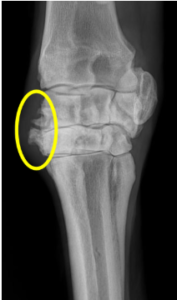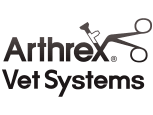Degenerative joint disease (DJD) or osteoarthritis occurs when the normal tissues within a joint begin to deteriorate. We often think about the cartilage surface when discussing DJD, which usually covers the ends of our bones and creates a cushioned, low-friction surface that allows for the gliding motion of joints. In DJD, this cartilage surface begins to break down and thin, and advanced DJD is sometimes described as “bone on bone” when the cartilage surface is essentially gone. In addition to thinning cartilage, we will see changes to other tissues within the joint, including the bone edges, joint capsule, and the fluid within the joint; the pain associated with DJD comes from all of these different components. DJD most often occurs due to chronic wear and tear on joints and, therefore, is most common in older horses; however, inflammation of a joint due to injury, infection, or conformation may predispose a joint to develop DJD.
DJD often presents as a chronic, slowly progressive lameness. It can be difficult to identify the lameness associated with DJD as an owner due to its slowly progressive nature. Additionally, DJD often occurs in multiple limbs, which can make the asymmetry typically associated with lameness more difficult to identify. Other early symptoms that owners often describe include:
- Poor or changed performance
- Change in attitude
- Reluctance or slow to lie down or rise
- Asymmetry or stiffness noted during exercise
The workup of a horse with suspected DJD typically starts with a thorough history. This can provide your veterinarian hints as to what joints may be painful and what therapy may be indicated. Some history of particular importance in working up a horse with suspected DJD includes how long symptoms have been noticed, if anything appears to improve or worsen symptoms, whether any lameness or evaluation has been present previously, and any treatment in the past. After a thorough history, your veterinarian will likely perform a lameness evaluation; this may include watching the horse move through a variety of motions and on various surfaces, flexion evaluation, and nerve or joint blocks. Once the location of the lameness is pinpointed, diagnostic imaging may be performed; often, DJD can be diagnosed with radiographs, but other imaging, including ultrasound, nuclear scintigraphy, CT, or MRI, may be warranted depending on the case (Figure 1).

Treatment may vary depending on the joint involved, the severity of the disease, and specifics about the individual patient. Successful management often involves a multimodal approach; this may involve medications (oral, injectable, and/or intra-articular), strength training, exercises to increase range of motion, and other conservative therapies. In severe cases, surgery is sometimes indicated, and your primary care veterinarian may refer you to an ACVS board-certified surgeon for consultation and treatment. Some of the more common treatments for DJD include:
- Intra-articular medications: The most common treatment for DJD is direct instillation of a medication or biologic into the affected joint. Steroids are potent anti-inflammatory medications and have a long history of use in managing DJD in horses and humans. Hyaluronic acid is a normal component of joint fluid and may be used alone or in combination with steroids. Over the last decade, a variety of ‘biologics’ have become more readily available for use in patients; these include products that are derived from the patient themselves and, after processing, can be injected directly into joints. The research around intra-articular therapeutics is continuing to grow, and we continue to have more information and products available to help our horses suffering from DJD.
- Oral anti-inflammatory medications: These medications provide systemic anti-inflammatory activity instead of the local activity of intra-articular medications. This group of medications includes the commonly used phenylbutazone and flunixin meglumine. However, these can cause side effects when used long-term. Some other options, including firocoxib, are safer for longer-term use but still need to be used with caution and horses monitored for side effects.
- Systemic injectable medications: Some of the commonly used injectable medications include intravenous hyaluronic acid or injectable polysuphated glycosaminoglycans. The mechanisms of action of these medications are theorized based on their natural function, but yet fully unknown. Anti-inflammatory functions of both classes of injectable medications are hypothesized, and there is evidence of improved clinical and microscopic signs of OA in several studies.
- Oral supplements: The most common supplements include glucosamine and/or chondroitin sulphate. These compounds are cartilage building blocks, and while the idea of supplementing them to help support healthy cartilage is enticing, studies supporting their efficacy in clinical cases are varied. Another consideration with these products is the highly variable contents of these supplements and whether they contain what the label claims. If you are considering using these products, do your homework when picking a supplement and use one with controlled research studies backing up its clinical efficacy and contents.
The aftercare will depend on the severity of the disease, the treatment course used, and other patient-specific factors. Often, these horses will be sorer with time off or stall rest, so if treatment is successful in managing lameness symptoms, maintain the patient in some degree of exercise to maintain. Ultimately, OA is a disease to be managed, not cured, so it will be important for the veterinarian, owner, and horse to work together in finding a long-term management strategy. It may take some trial and error to decide on the best treatment plan for a given individual, and it is important not to get frustrated if the first therapy doesn’t solve the lameness. Overall, many horses can be successfully managed and maintain athletic careers, but more severe disease or OA of specific joints may be more limiting, even at initial diagnosis, and the progressive nature of OA may result in performance limitations later in life.













